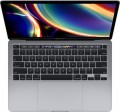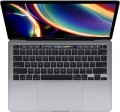Model
The specific model of the processor installed in the laptop, or rather, the processor index within its series (see above). Knowing the full name of the processor (series and model), you can find detailed information on it (up to practical reviews) and clarify its capabilities.
Code name
The code name for CPU installed in the laptop.
This parameter characterizes, first of all, the generation to which the processor belongs, and the microarchitecture used in it. At the same time, chips with different code names can belong to the same microarchitecture/generation; in such cases, they differ in other parameters - general positioning, belonging to certain series (see above), the presence / absence of certain specific functions, etc.
Nowadays, the following code names are relevant in Intel processors:
Coffee Lake,
Comet Lake,
Ice Lake,
Tiger Lake,
Jasper Lake,
Alder Lake,
Raptor Lake (13th Gen),
Alder Lake-N,
Raptor Lake (14th Gen),
Meteor Lake (Series 1),
Raptor Lake (Series 1),
Lunar Lake (Series 2).
For AMD, the list looks like this:
Zen 2 Renoir,
Zen 2 Lucienne,
Zen 3 Cezanne,
Zen 3 Barcelo,
Zen 3+ Rembrandt,
Zen 3+ Rembrandt R,
Zen 2 Mendocino,
Zen 3 Barcelo R,
Zen 4 Dragon Range,
Zen 4 Phoenix
Zen 4 Hawk Point,
Zen 5 Strix Point.
Detailed data on different code names can be found in special sources.
CPU speed
The clock speed of the processor installed in the laptop (for multi-core processors, the frequency of each individual core).
Theoretically, a higher clock speed has a positive effect on performance, as it allows the processor to perform more operations per unit of time. However, in fact, the capabilities of the CPU depend on a number of other characteristics — primarily on the series to which it belongs (see above). It even happens that of the two chips, the more performant in the overall result is the slower one. With this in mind, it makes sense to compare by clock frequency only processors of the same series, and ideally, also of the same generation; and the laptop as a whole should be judged by the complex characteristics of the system, as well as by the results of tests (see below).
TurboBoost / TurboCore frequency
Processor clock speed achieved in TurboBoost or TurboCore "overclocking" mode.
Turbo Boost and Turbo Core technologies are used by different manufacturers (Intel and AMD, respectively), but they have the same principle of operation: load distribution from more loaded processor cores to less loaded ones to improve performance. The "overclocking" mode is characterized by an increased clock frequency, and it is indicated in this case.
For more information about clock speed in general, see the relevant paragraph above.
Passmark CPU Mark
The result shown by the laptop processor in the Passmark CPU Mark test.
Passmark CPU Mark is a comprehensive test that is more detailed and reliable than the popular 3DMark06 (see above). It checks not only the gaming capabilities of the CPU, but also its performance in other modes, based on which it displays the overall score; this score can be used to fairly reliably evaluate the processor as a whole (the more points, the higher the performance).
RAM
The amount of random access memory (RAM or RAM) actually installed in the laptop.
The amount of RAM is one of the most important indicators characterizing the overall flow Rate of the system. The more RAM installed in a laptop, the better it will cope with “heavy” resource-intensive programs, and the more tasks can be performed on it simultaneously without “brakes” and failures.
Today
, 4 GB of RAM is considered the minimum required. A capacity of
8 GB is usually enough for comfortable household use and simple games,
16 GB and
32 GB are enough for running resource-intensive applications and confidently launching modern games. And in advanced gaming and professional laptops there are also larger amounts of RAM -
64 GB or even more.
Note that many laptop models allow you to increase the available amount of RAM; For more details, see “Maximum installed volume”.
RAM type
Laptops mainly use different variants of DDR (so-called double data transfer memory). Here is a list of common types of such memory:
— DDR3. Third generation DDR RAM. Outperforms outdated DDR2 in terms of speed and power efficiency. However, it is also outdated against the background of the fourth version and new items - DDR5.
— DDR3L. A modification of DDR3 memory that supports operation at a reduced voltage - 1.35 V instead of 1.5 V (Low Voltage - hence the index L). Lower voltage contributes to both lower power consumption and better performance. Note that conventional DDR3 memory cannot be installed in such a slot, while the reverse option is quite possible.
—
DDR4. A memory standard released in 2014. Introduced further improvements in speed (up to 25.6 GB / s in the future) and energy efficiency. The most popular among laptops of recent years of release.
—
DDR5. The procession of the fifth generation of the DDR standard began at the turn of 2020-2021. It provides for approximately a twofold increase in memory subsystem performance and increased bandwidth compared to DDR4. Instead of a single 64-bit data channel, DDR5 uses a pair of independent 32-bit channels that work with 16-byte packets and allow 64 bytes of information to be delivered per clock on each channel. New memory modules require a voltage of 1.1 V, and the maximum volume of one DDR5 bar can rea
...ch an impressive 128 GB.
It is worth noting that different types of RAM are not interchangeable.
Some laptops have LPDDR4, LPDDR4X, LPDDR5, LPDDR5X RAM. It was developed by a specialist for mobile devices and is non-expandable, since the corresponding memory modules are built directly into the motherboard. The use of "RAM" standards LPDDR is determined by the achievement of an optimal balance between the performance of the laptop, its size and battery life.RAM speed
The clock speed of the RAM installed in the laptop.
The higher the frequency (with the same type and amount of memory) — the higher the performance of RAM in general and the faster the laptop will cope with resource-intensive tasks. However modules with the same frequency may differ somewhat in actual performance due to differences in other characteristics; but this difference becomes significant only in very specific cases, for the average user it is not critical. As for specific values, the most popular modules on the modern market are
2400 MHz,
2666 MHz,
2933 MHz and
3200 MHz. Memory at
2133 MHz or less is found mainly in outdated and low-cost devices, and in high-performance configurations this parameter is
2933 MHz,
3200 MHz,
4266 MHz,
4800 MHz,
5200 MHz,
5500 MHz,
5600 MHz and
more.
Graphics card model
GeForce graphics cards from NVIDIA:
RTX represented by
RTX 2060,
RTX 2060 Max-Q,
RTX 2070,
RTX 2070 Max-Q,
RTX 2070 Super, RTX
2070 Super Max-Q,
RTX 2080,
RTX 2080 Max-Q,
RTX 2080 Super,
RTX 2080 Super Max-Q,
RTX 3050,
RTX 3050 Ti,
RTX 3060,
RTX 3060 Max-Q,
RTX 3070,
RTX 3070 Max-Q, RTX 3070 Ti, RTX 3080,
RTX 3080 Ti,
RTX 4050,
RTX 4060,
R TX 4070,
RTX 4080,
RTX 4090 ;
MX1xx represented by MX110, MX130 and MX150,
MX2xx(MX230 and MX250),
MX3xx(MX330 and MX350),
MX450, GTX which represent GTX 1050,
GTX 1060,
GTX 1060 Max-Q,
GTX 1070,
GTX 1070 Max-Q,
GTX 1080,
GTX 1080 Max-Q,
GTX 1650,
GTX 1650 Max-Q,
GTX 1650 Ti,
GTX 1660 Ti,
GTX 1660 Ti Max-Q and. AMD also offers video cards
Radeon 520,
Radeon 530(535),
Radeon 540X,
Radeon 610(625, 630),
Radeon RX 550 (550X, 560),
Radeon RX 640,
Radeon RX 5500M,
Radeon RX 6800M and
Radeon Pro.
Note that all the above models are discrete. Actually, for a configuration with discrete graphics, it is the model of a separate video adapter that is indicated; if it is supplemented by an integrated module, the name of this module can be clarified by the official characteristics of the processor.
It is also worth mentioning that this paragraph does not give the full name of the model, but only its name within the series (the series itself is given separately - see above). However, knowing the series and model, one can easily find detailed information about the graphics card.

